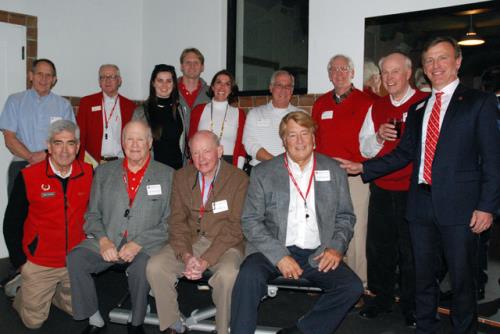
Attendees at Baylor alumni event at Common House
photo by Baylor School
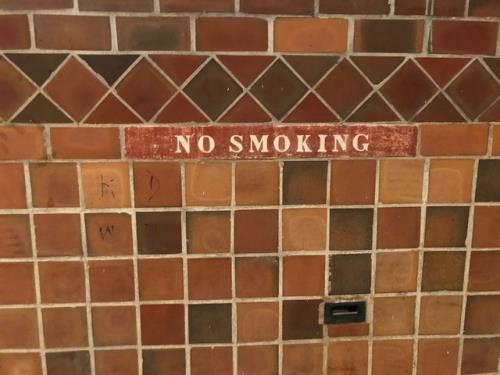
Old tiles that lined Industrial YMCA pool room wall
photo by John Shearer
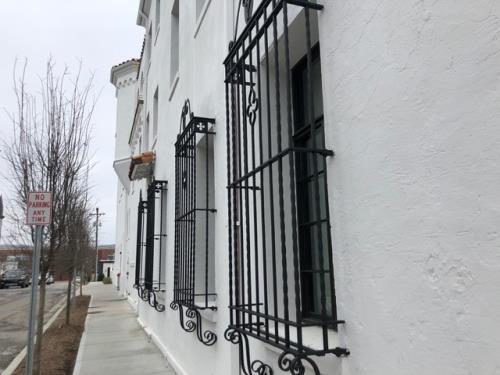
Common House/former Industrial YMCA
photo by John Shearer
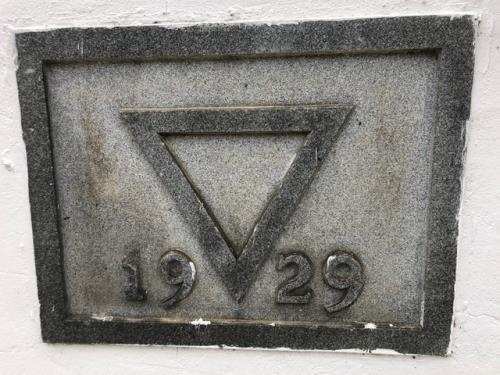
Common House/former Industrial YMCA
photo by John Shearer
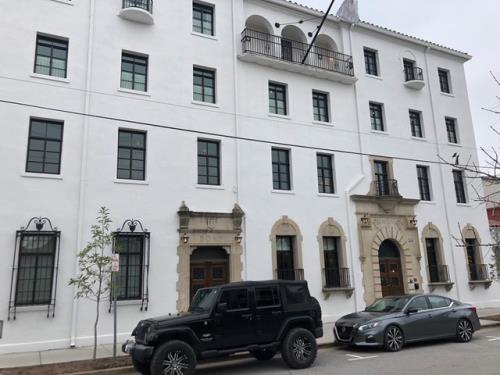
Common House/former Industrial YMCA
photo by John Shearer
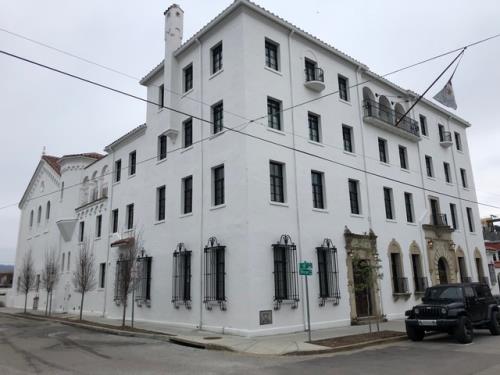
Common House/former Industrial YMCA
photo by John Shearer
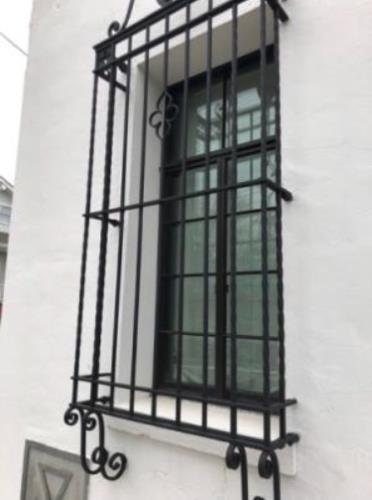
Common House/former Industrial YMCA
photo by John Shearer
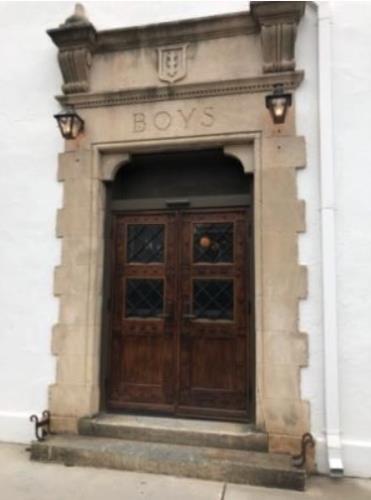
Common House/former Industrial YMCA
photo by John Shearer
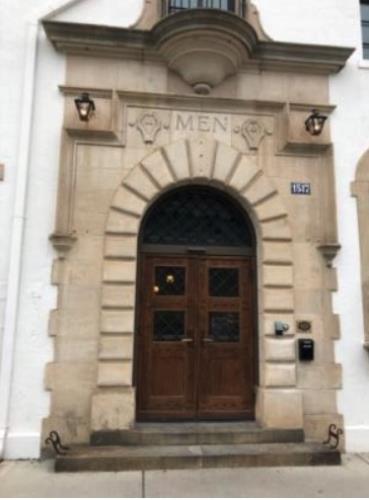
Common House/former Industrial YMCA
photo by John Shearer
Prior to Christmas and the other festive winter holidays, Baylor School held an alumni holiday gathering for the first time at the new Common House at 1517 Mitchell Ave. near Main Street.
But for a small number of people, the event at the new social and dining club was a trip back to see an important part of their youthful past. For a brief period from the 1957-58 school year until Baylor’s first on-campus indoor pool opened in late 1963, this building that was formerly the Industrial YMCA was where the Baylor swim team practiced and competed.
As a result, several attending the holiday gathering were seeing an old inanimate friend in addition to fellow alumni.
“I have not been in here since then until this event,” said Greg Wright, a member of the class of 1964, as he toured the room where the pool sits. “I only swam in it for three or four months before the new pool opened at Baylor.
“This was a lot smaller. The new pool was a better facility and better structure, but this worked well for us.”
Mr. Wright, a standout swimmer and three-sport athlete at Baylor, who went off to the University of Minnesota in his home state after one year, was joined by several other former swimmers for a special tour before the regular alumni gathering. They included Max Brener ’59, Steven Sawrie ’59, Joe Robbins ’60 and Jim Hellman ’69, who was a seventh grader the last year Baylor swam there.
The idea for the event had been initiated by Jim Frierson ’67, who had joined the Common House and began thinking about the history of Baylor swimming there, particularly after he noticed the familiar tiles from old yearbook photos of the team. “This was the birth of the Baylor swim team right here,” he told a gathering in the former gymnasium before the building tour.
All that got me – a non-competitive swimmer as a youth, but one who regularly covered the state swim meet and other events for the Knoxville News Sentinel while living in Knoxville from 2005-17 – thinking about some history of local competitive indoor swimming.
While this brief chronicle is by no means complete, I have included some McCallie and Girls Preparatory School swimming history as well after recapping the Baylor alumni event and the school’s history with the old Industrial YMCA building. And the three schools are not the only ones who have contributed to the rich local indoor competitive swim history, as I came across the fact that the Notre Dame High girls won the state meet in 1968.
Some more history is to be made this weekend, as the 2022 TISCA state meet is being held at the Tracy Caulkins Pool in Nashville for this non-TSSAA sport. Both Baylor and McCallie are expected to do well in the boys, after McCallie had an exciting one-point win in the dual meet, while the Baylor girls are also expected to vie for the championship after beating their rival, GPS, in the regular season.
The Mediterranean-style Industrial YMCA, which was designed by Chattanooga architect Clarence Jones, was built in 1929 and served as a Y into the 1980s. It also in later years served as a youth residence center and as the home of Inner-City Ministries. New City Fellowship also worshiped there for a period beginning in the 1970s. Chattanooga’s main YMCA was for years located on Georgia Avenue next to the Dome Building until the current Y by West Sixth Street near Cameron Hill opened in 1969. The Georgia Avenue building next to the old Carnegie Library was subsequently torn down.
A better fate resulted for the Mitchell Avenue building, although it was vacant for a period. It was later purchased, stabilized, and maintained by Jack Kruesi from the Baylor class of 1964, another former swimmer, until a suitable use could be found for the now-blossoming Southside area. Common House is a Charlottesville, Va.- based company that has been turning a variety of properties in different cities into social clubs that are known for their amenities and eclectic membership.
The old Industrial YMCA building has been greatly restored to keep the main architectural features, although parts of it have been slightly remodeled and reconfigured for use as a club. The old swimming pool on the lower level was covered but was not filled in and now makes great storage, officials say. Over the new flooring, an exercise room is on one end, and restrooms/dressing rooms are on the other side across a hallway that has been created.
But the changes did not keep the nostalgic memories from flowing like the waves once made by the swimmers in the small pool.
The idea for Baylor using the building back in the 1950s had come from the late Stan Lewis, who served as Baylor’s first swim coach, said his son, Matt, who now serves as chief advancement officer at Baylor. The elder Mr. Lewis – who had been a competitive swimmer as a youth in Evanston, Illinois, and while attending Wesleyan University in Connecticut -- had tried to encourage the school to start a program.
The younger Mr. Lewis said rival McCallie School had an indoor pool earlier than Baylor did, although the original and now-gone outdoor Baylor pool near the river had been used in the summertime since the 1920s. So, the Industrial Y was a start, despite its limitations as a small pool.
“It was like a big bathtub,” joked Matt, who also attended the alumni gathering and remembered going with his father to the pool for practice and meets as a small child. “It was very hot in there. Very humid. Almost a cloud. I just remember how narrow it was, even for a little boy. The lanes were really narrow, and guys would be locking arms.
“And the waves that would be generated. You would come up for a breath of air and get a mouth full of water. It was a hard place to swim.
“And diving was a real challenge. It really wasn’t deep enough.”
Because of these limitations in this pool likely designed more for casual recreation, and due to the growing popularity of Baylor’s swim program, the school decided to build a pool onto the newer gymnasium. The John Martin Company built the brick addition that uniquely allowed the visiting basketball stands to be reversed, while the Cox Engineering Co. of Birmingham built the pool.
The pool facility, designed after one at Indiana University, was unique for the time in that it had a separate diving well.
According to the Baylor history book, “It Never Rains After Three O’Clock,” by James Hitt, the new facility was aided with the financial support and volunteer leadership of Mr. and Mrs. H. Clay Evans Johnson. They had also asked that the facility be available for use by Girls Preparatory School as well, and a separate dressing and shower facility for girls was built.
The facility opened in late 1963, and a few months later was officially called the Calvin Smith Jr. Natatorium in memory of Mr. Smith. He was a 1958 Baylor alumnus and U.S. Marine captain, who had died on Dec. 30, 1963, after his Skyhawk jet crashed in Pamlico Sound off the North Carolina coast during training.
The building served until the current Baylor Natatorium was built in 2006, and the older pool became part of the Luke Worsham Wrestling Arena. Now Baylor, McCallie and GPS all have their own upscale swim facilities, and each regularly competes for state titles.
But at the recent holiday event, a few Baylor alums who got the program started had a chance to reminisce at the old Industrial YMCA building about the humbler early days.
Matt Lewis thinks his late father would have gotten a kick out of the gathering. “He loved to talk romantically about the old Industrial Y,” he said. “My dad looked back affectionately and romantically on this pool.”
* * * * *
According to some information passed along by McCallie School historian and archivist John McCall from the Class of 1961, McCallie’s competitive swim history also involved using the Industrial YMCA.
He also said that McCallie had participated in some form of competitive swimming since at least 1920, and it continued through World War II.
“McCallie used to practice and hold meets in the McCallie Lake during the 1930s and '40s,” said Mr. McCall. “Swimming was a spring sport. (Successful former coach) John Pataky (from the McCallie class of 1949) remembers this.”
Mr. McCall also published a school history book in 2009 called “On This Day in McCallie’s History,” and it includes references to McCallie winning a Tennessee Invitational meet in Knoxville in 1935 and swimming practice being canceled due to rain in 1947.
Before 1958, Baylor and McCallie actually swam once competitively against each other in a dual meet in 1943 in a McCallie victory, according to records passed along by Mr. McCall. Whether that was more of a club team for Baylor or hastily pulled together squad is not known.
Mr. McCall said he also learned that by the early 1950s, McCallie practices and local meets were being held at the old Industrial Y. This would have been a short time before Baylor began using the facility.
There was likely a little overlap of the two schools there when Baylor started at the Y, unless McCallie found another place, because the Blue Tornado did not dedicate its Goree Nelson Memorial Pool on its campus until 1959.
After the John T. Pataky Aquatic Center opened in the school’s Sports and Activities Center in 1991, the former McCallie pool became a recreation game room.
* * * * *
Patrice Glass of GPS also passed along some information about the Bruisers’ journey to competitive swimming. She said that GPS began swimming classes in 1963 using the Baylor pool and started synchronized swimming classes at that time as well.
It is not known if GPS before that ever used the old and still-standing former YWCA building on East Eighth Street for at least recreational swimming, as it was located near the school’s downtown campuses in the early days before World War II.
By 1967, the school had a competitive swim program and would quickly go on to a glory period, winning state championships in 1969, 1970, 1971, 1972, 1974, 1975 and 1976 – apparently while also using the Baylor pool.
And on top of all that, GPS uniquely formed a Catalina Club in 1968 for students in upper grades interested in synchronized swimming.
GPS’ long road to having its own pool came to fruition in 1992, when a competitive swim facility opened as part of the large C.G. Mills Complex that also included a theater, gym, locker rooms, and music and theater classrooms.
In a school centennial history Ms. Glass put together in 2006, she wrote, "School leaders began discussing the need for GPS to have an indoor pool in the 1950s, and it remained a topic throughout every subsequent building phase of the school's history.
"However, board members and administrators engaged in moving the school forward always found it necessary to push the building of a pool a little further down the priority list. Fortunately, the 1988 Master Building Plan included a pool. Construction of the six-lane, 113-foot-long pool finally meant that GPS's swim team did not have to travel off campus for all practices and meets."
* * * * *
Besides GPS’ seven state championships and the lone win for Notre Dame’s girls, the Baylor boys and girls and the McCallie boys have won plenty of state championships.
According to state meet records, McCallie won state championships in 1969, 1970, 1971, 1973, 1975, 1976, 1977, 1978, 1979, 1980, 1981, 1991, 1998, 1999, 2000, 2001, 2002, 2003, 2004, 2019 and 2020 (tie with Baylor).
Baylor’s boys won state championships in 1968, 1972, 1974, 1982, 1983, 1984, 1985, 1986, 1987, 1988, 1989, 1990, 1992, 1993, 1994, 1995, 1996, 1997, 2007, 2008, 2009, 2013, 2014, 2015, 2017, 2018, 2020 (tie), and 2021.
The Baylor girls have won state championships in 1990, 1992, 1993, 1994, 1995, 1996, 1997, 1998, 2008, 2009, 2010, 2011, 2012, 2013, 2019, 2020, 2021. Baylor became coed in 1985, and it did not have its first graduating girl seniors until 1988.
Baylor has also won numerous combined boys and girls state championships, and Baylor and McCallie also competed for Mid-South titles before the state meet began being held in the late 1960s.
* * * * *
Jcshearer2@comcast.net